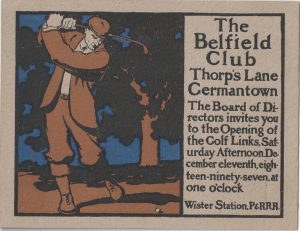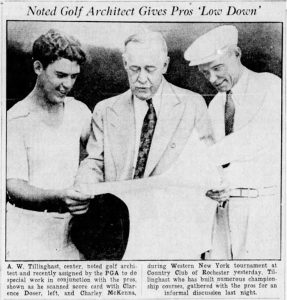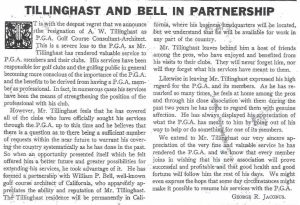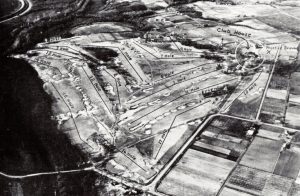Feature Interview No. 3 with Phil Young
December, 2021
1. When and where Tillinghast first got into design?
I believe that it was at least as early as 1898. In the January 1909 issue of The American Golfer, Tilly wrote, “Some years ago I was invited to run out to Frankford, a suburb of Philadelphia where at that time golf had yet to be introduced. Selecting the most available ground, I laid out a rather crude course, using for holes, tin cans which had once contained French peas.”
There are several questions that are almost never asked about that account. The first is, who invited him there to lay out this crude course? I believe it was Jones Wister, one of the founding members of Belfield Country Club as were Tilly and his father. It was the Wister family that donated land from the old Wister farm to be used as a public park and it was on this site that Tilly laid out this crude course.
The second question is, why did he ask Tilly to do this? The answer can only be that Tilly had already been speaking within his community of friends about golf and his love for the game and the courses on which he was playing. He was already recognized by them as a fairly accomplished player. Yet there was more involved than that.
The Belfield Club, the predecessor to the new Belfield Golf Club, was founded in 1890. In 1898 the members decided to become a golf club with their own golf course. Tilly didn’t lay out this course, that was done by E. K. Tryon, Jr. & Co. So that leads to a third question. Why not have Tryon lay out this crude course? Because it was to be temporary and its sole purpose was to teach those in the community how to play golf, possibly in hopes that they would be interested in joining the new Belfield Golf Club. Who better to turn to than Tilly to give the public free lessons while being the consummate PR person for the new club.

2. Your research shows that Tillinghast’s father and he were founding members of Belmont Golf Club and that he redesigned it and expanded it to eighteen holes in 1906. Is that correct? Put that into perspective for us.
That is correct. In the January 26th, 1906 edition of the Philadelphia Inquirer, an article reported that, “At a meeting of the members of the Belfield Country Club it was unanimously decided to…improve the grounds and golf links…They expect that the golf links will be the
finest near the city when improvements are completed.”
There is no specific information given as to exactly what was done to the course nor was the architect making the changes named. We can see, though, that it was lengthened and an additional nine holes added by an article that Tilly wrote as “Hazard” in the May, 1910 issue of
The American Golfer, that stated: “The Belfield CC has secured the ground beyond the fourth green and will be thus enabled to add a long three-shot hole to take the place of the short ninth… This change is a good one and will bring the par of the course up to 72.”
Changing the par by replacing a short hole whose par was either 3 or 4 with one whose par was 5 means the course was 18 holes with a par of 70 or 71.
In his 1926 tri-fold advertising brochure, Tilly listed Belfield as a course that he had “reconstructed and extended.” There is no record of it being extended after this date and before 1926. That provides secondary proof that the expansion to 18 holes was done in 1906. That also
means that in order for Tilly to have “redesigned and extended the course” it would have to have been in 1906.
Why would Belfield CC turn to him to redesign the course? Consider that in January, 1905, the year before the club decided to change it, Tilly was awarded the Silver Cross medal by G.A.P. as the best player of the year in 1904. He was also the course record holder at Belfield and was on the board of directors when it was decided to redesign and expand the course. Also, the president of the club in 1903 and possibly in the year or so after, his friend Jones Wister.
Most important of all, Tilly had already been “advising golf clubs on how to improve their golf courses” before this time. He was quoted in a number of newspaper interviews in the early 1930s that he had been doing this for more than 30 years. In addition, Tilly, in his famous 1942 letter to Donald Ross written just a few months before he died, he stated: “For a time the doctors gave me but small chance but my reserve pulled me through eventually, but I received strict orders against continuing any sort of golf work. This was very tough on a man who had followed such from 1905, particularly one who loved it as much as I.”
3. Tillinghast toured courses across America on behalf of the P.G.A. from August, 1935 to December, 1937. George Jacobus, the president of the P.G.A., stated beforehand that ‘It is the aim of the P.G.A. to create a better understanding of the necessities of good course construction and economical ways of accomplishing desired results.’ Was that goal accomplished?
Yes, it was. In my new book, Tillinghast Chronicles Volume II: The Golf Courses of A. W. Tillinghast, of the more than 230 courses listed to which he worked on, 48 of these can be shown by contemporary sources that they followed through on reconstructing them per Tilly’s instructions that he made after inspecting them on this tour. These are substantial re-dos and not simply a case of ridding their course of a few “Duffers headaches” bunkers. Based on much of the information in his daily letters to the PGA, I am convinced that a number of others followed through on implementing his recommendations, as well.
Here is an example of one. It is taken from the Long Vue Club’s website: “Prolific golf architect Albert Warren Tillinghast renovated the course in 1935, making several recommendations to improve on the original layout. Tillinghast’s contributions left a lasting mark, and truly made Longue Vue’s course what it is today.”
The most important thing the Tour accomplished was the saving of their jobs for numerous PGA pros. Because of the Depression, many clubs were trying to find ways to justify having a professional for their members. This free service, which in many cases were overseen by their professional at no cost to the club, provided actual savings in maintenance while improving the golf course, all because they had a PGA professional on their staff.

4. Tillinghast wrote letters almost on daily basis to Jacobus. What are some favorite/most revealing quotes?
• “It will be interesting to know that I met my first rebuff of the trip, here at Chicago. At the meeting a certain P.G.A. member requested the service at his club and it was scheduled among the others. A few days later he telephones and seemed to be considerably embarrassed when he was forced to recall his request at the insistence of his club’s president, who said that his course required no outside assistance at all. When the pro’ added that his president was an amateur golf architect, the situation was apparent and rather amusing. I told our member to think nothing more about it as I thoroughly understood his position.”
• “The Automobile Association here at last succeeded in getting my 1936 automobile license plates and registration certificate from the East. These arrived yesterday, after considerable delay, and I would have been in a bad spot had they not come through, for the present California laws are very strict and the extension of time allowed me was at an end. So all is well and a load is lifted from my mind.”
• “I arrived here tonight after a terrible day, driving 290 miles through the rain over frequently treacherous roads. I started from Los Angeles this morning, intending to take the first start of my journey to Oakland, through the Cahuenga Pass, to Bakersfield and then, after checking up the work I outlined for them last winter, to continue on through Fresno. However, the rain was heavy and when I had gone some twenty miles beyond San Fernando, into some real mountain country, I was halted by the state police and sent back to San Fernando. They told me that heavy snows were practically putting the route out of consideration for motoring. Afterwards I learned that several hours later, at this place, a large plane had crashed, killing one man and seriously injuring a number of others, among them Martin Johnson (the African Explorer). Finally I got to Paso Robles after a much longer drive along the coast.”
• “It rained yesterday (Sunday) and it has showered intermittently today. However I was able to make a complete examination of the nine holes course of the Standard Country Club, at the request of P.G.A. member, Charles Vittitoe, who is also Secretary of the Kentucky Section of the P.G.A. The synopsis of my findings there is enclosed for our office file. It is self-explanatory. This course is about the worst I have ever investigated. It is the only Jewish club in Kentucky and there is an element there, which strongly favors the building of an entirely new course with Vittitoe and he requested that I spare not the whip but frankly set forth the real truth, which I have done and a copy prepared for Vittitoe at his urgent request. It is decidedly to his advantage if the course of his club is worthy of his name.”
• “The one shot that tells the story in golf is the shot to the green, and if you conceive of golf as a game of animate attack and inanimate defense with regard to that shot, you have my theory of design in a nutshell.” This was from an interview published in the Boston Herald on during the PGA Tour on September 6th, 1936.
5. What are three specific tangibles that came from that trip?
It re-invigorated the belief by the individual professional members that their membership in the PGA was worthwhile for them to keep by paying their dues at a time when all of them were hurting financially because of the Depression.
In the eyes of many club’s board of directors and owners, their professionals became far more than a simple employee and were now viewed as adding great value to the club. Because of the incredible response that Tilly received at the clubs he visited on the west coast, he became convinced him that his future in golf course architectural design lay out there.
This led to his move from New Jersey to California and his short-lived partnership with Billy Bell Sr.

6. Talk to us about Tillinghast’s visit with Donald Ross in Pinehurst in December, 1935. This was unquestionably one of, if not the most personally moving day during his tour for the PGA.
Tilly and Ross were friends going back to at least the beginnings of the century. He was also friends with Ross’ brother Alec. His wife, Lillian, who was traveling with him, spent much of the day with Ross’ wife. He considered Ross to be a consummate golf course architect. He was deeply impressed by his work and considered many of them to be among the highest masterworks of design. Yet what he saw during his tour of #2 with Ross that day transcended every other one of Ross’ designs.
7. So you believe that Ross was offered a similar role but passed?
Tilly wrote in his letter to George Jacobus, President of the PGA, “I was fortunate to find Donald Ross at home and for quite a while I sat in his house and discussed with him the P.G.A. course service. As you recall, he was not inclined to favor this when it was first proposed.” Evidently Tilly and Ross were both approached by George Jacobus to take part in it.
8. The guided tour over No. 2 as it was readied for the P.G.A. Championship must have been something else. Tillinghast seemed genuinely impressed?
He was deeply moved by Ross insisting that he give him a tour of #2. Tilly wrote in that day’s letter to the PGA: “His welcome was most cordial and he insisted on showing me every hole of the Number 2 course, where next year’s P.G.A. National Championship will be played. We
analyzed the various holes together. Donald is certain that this is his greatest piece of work and he is tremendously proud of it, as he may well be for it is truly a great course, without a single weak hole, without a doubt one of the greatest of all American courses. I whole-heartedly congratulated him on his great achievement and he was pleased when I told him that I would write a story about the course for a future number of the P.G.A. magazine. I believe that such a story will prove of great interest to the professionals of the association, throughout the country. I enclose a card of the course for your inspection. [The article that Tilly would write is titled, “The Masterpiece of Donald Ross,” and can be found beginning on page 8 of the February, 1936 issue of the Professional Golfers of America magazine.]”
Tilly was so impressed with his tour of the course, that when asked in an interview several months later to list the five greatest golf courses in America, he placed Pinehurst #2 second behind only Pine Valley. This was the only time he ever set foot on the course.
9. What other architects did Tillinghast meet during his journey for the P.G.A.?
Among those named in his PGA letters, listed alphabetically, are: William (Billy) Bell Sr., William (Bill) Connellan who once worked for Tilly, Ed Dearie, A. Douglas Dodge, Robert Hunter, Emil Loeffler, Perry Maxwell, Henry J. Marquardt (Landscape Engineer), Donald Ross and R. J. Ross (no relation to Donald Ross).
He met other architects during the tour during the sectional PGA meetings that he conducted to educate the local professionals about the “Service” that he was doing. Invited to many of these meetings were local greenkeepers and golf course architects. In addition, he recommended to some courses to contact specific architects to implement the recommendations he made to them. Among these were Perry Maxwell to Brook Hollow and William Flynn to several Philadelphia area clubs.
10. Did he write glowingly of any particular courses that he saw?
Houston Country Club: “I was particularly pleased with my inspection of the course of the Houston Country Club, which was made in the company of Willie Maguire, his greenkeeper C. P. Welti and E. G. Goforth, Chairman of the Green committee. Maguire’s long experience in the
developing Bermuda turf and winter greens of Bermuda base is well proved here. Indeed he has developed the best greens of this type that I have ever observed.”
Denver Country Club: “This morning I visited the course of the Denver Country Club at the request of P.G.A. member John Rogers. Together we were accompanied around the course by the chairman of the green committee, Fred W. McCartney, a former president of this old organization and one who has always been most prominent in the development of this course. The wisdom of this gentleman is reflected by the character of the work which has been continuing gradually to
keep the course abreast of modern golf.”
Oakland Hills Country Club: After inspecting it in 1936, he wrote an article for the PGA magazine that went into great detail about the course and the minor changes made to it in preparation for the 1937 U. S. Open. Among his comments he wrote: “In closing, let me again say
that Oakland Hills is entirely worthy of this great professional event and there is sure to be a great tournament over a great course. And there is one characteristic of most of the holes–the wonderfully fine breaks of the fairway in front of the greens. In this rather sketchy view of the course for the 1937 U.S. Open, it may be well to add that I think I have never seen a better one for spectators. It will not be difficult to handle big galleries here, and there are several locations from which much of the play may be observed without tramping with the herd.”
Riviera Country Club: “Later I made a visit to the Riviera course. Riviera is rated as one of the outstanding courses of this district and my first views of it tend to confirm this fact.”
The Valley Club: “This afternoon I went with Lew Scott to his course, The Valley Club, one of the most distinguished courses in southern California. Thornton Connover, the greenkeeper, accompanied us in the examination of the course. Afterwards I talked with the Chairman of the green committee, answering such queries as he put to me, and also with Robert Hunter who collaborated with Dr. MacKenzie in 1929, when the course was built. I complimented Hunter particularly on the masterly manner in which the approaches to the greens were contoured. This is a most notable feature of this notably fine collection of holes.”
11. Time and time again, Tillinghast called for the removal of poorly placed bunkers, essentially stating that such bunkers added a needless maintenance expense and primarily penalized the duffer. What accounts for so many hazards being so poorly arranged?
Golf course architecture in America was still in its infancy, even in the 1930s. Even clubs that expanded existing courses or moved locations to create new ones in order to have “championship courses” were mostly concentrating on length and not strategy. Strategic thinking in the design of courses was quite rare, and many courses designed in the teens and twenties were not of that type. This especially could be seen in the placement of bunkers and other hazards, and so this is how the vast majority of clubs expected to be built. Think of it this way, someone who is raised eating a great deal of fast food is absolutely stunned by the steaks served in restaurants such as Ruby Tuesdays, at which I’ve enjoyed an enjoyable. Yet just as it was the rare few who got to enjoy a meal at Peter Luger’s, so it was the rare few who
could play the courses such as Pine Valley and Oakmont.
Even among the really good architects during that time, few planned for the future in their designs. Expansion and lengthening of most courses during that time was the best they understood to do, yet rarely with strategy in mind. As a result, the majority of architects
designing courses at that time were learning themselves that their understanding of what was outstanding design needed to evolve just as their existing courses did.
Tilly was different in this. Even his earliest writings about design show how different his perception of what good design was from the other architects of his time. This also included his understanding that courses would evolve and change and to plan for it where possible. For example, he left recommendations with sketches for future changes to be made to what he had just designed and built in the years that followed at a number of clubs. These were to keep the course relevant due to changes in how he expected the average to great players played the game due to changes and advancements in equipment. Among these was San Francisco Golf Club. The course changes made in 1930 were done from recommendations for the future that he left with the club. This was confirmed in an interview with Dixwell Davenport, chairman of the green committee who was overseeing this project at that time, published in the July 30th, 1930 issue of the San Francisco Chronicle, in which he stated: “When architect Tillinghast turned over the old course to the San Francisco club he left suggestions for future development. These are now being carried into effect, say directors of the club.”
That Tilly expected that his courses should evolve with the time can also be seen in what he wrote to Jacobus regarding Brackenridge Park: “I planned the course exactly twenty years ago. I was rather disappointed in it for there seems little effort to keep pace with the advance of golf during the twenty years of its existence.”
12. Tillinghast’s recommendations often times centered on cutting expenses and making courses more fun for all. That is laudable but did he make courses more interesting for the ace player as well during this journey?
Yes he did. This can be seen in the numerous times he recommended the creation of a “Master Trap” on existing and new holes to be built. The purpose of these, would provide the greatest challenge to the best player, while the lesser player, although not able to challenge this hazard, would still be able to play short of the green and then on with a put for a possible par or onto an open portion of the green from which he could hopefully two-putt.
13. Tillinghast died in 1942, meaning that the last 13 years of his life were shaped to a certain extent by the Great Depression and his P.G.A. journey. Without question, he gave back to the sport during very tough economic times. What is his most notable original design during that period?
Unquestionably it is Bethpage Black. Unfortunately, he only worked on a small number of courses during those years. Yet what sets the Black apart from every other course that he ever designed is how he personally viewed it. He called it the “Black Leopard” and compared it to Pine Valley in his article “Mankillers.” One need only read that article to appreciate the depth of his pride in how it turned out.
14. Talk to us about Brook Hollow – what made it a special Tillinghast design?
Two words…Cameron Buxton. They were close friends, both during his playing years and after when he moved to Dallas. Buxton was the moving force behind its creation and oversaw the project for the club. In the teens, Tilly wrote that, “no one has had more to do with the building of Pine Valley than Cameron Buxton.” He was a founding member of and spent most of his summers staying at Pine Valley. He did so until his untimely death in the mid-1920s.
Buxton envisioned creating a course in Dallas that could rival Pine Valley, an idea that Tilly would embrace. This can be seen in its massive number of bunkers throughout the course including a Hell’s Half Acre complex on the 15th hole. Yet his use of his “Master Trap” concept was used exceedingly well in the green complexes. Also, the angles of play to these greens, as well as how the course flowed throughout this remarkable piece of land were accentuated by the movements in it.
Yet more than its challenging length for the time (Tilly lengthened it from the original 6,300 yards when opened in 1922 to 6,600 in 1923 when he redesigned it in response to a severe drought and flood), the entrance to along with the flow and movements of the putting surfaces, made it both challenging for the expert and yet provided the lesser player with an enjoyable experience.

Brook Hollow aerial photograph ca. 1925.
15. Tell us about Keith Foster’s work there in 2019/2020.
Keith and I are good friends, and I’ve had the privilege of being involved in very minor ways on several of his projects including Brook Hollow. What sets him apart from almost every other architect working on Golden Age courses are two things. Here are three examples of his attention to details.
The revitalized 10th hole plays the same as when Tilly designed it, yet there are two relatively minor changes that have made it far more challenging for the expert player while also making it easier for the average one. These are the widening of the teeing area so that it extends as close to the pro shop as possible. This creates numerous challenging and fun angles into the green for every hole location. The most exciting one is enabled by the second one, the slight expansion of the putting surface behind the restored front right Master Trap, lengthening it at an angle further to the right and longer up the rear hill, thus creating extremely challenging hole locations for the expert player trying to make birdie or even par and a fun challenge for the lesser one.
The key part of restoring the Hell’s Half-Acre complex across the 15th fairway was also found in a tiny detail, that is, how close to the entry into it should the fairway be brought? He appreciated that having a rough cut before the hazard began would unfairly punish the lesser player. Consider that hitting from rough with a huge bunker that also contained grass mounds just a few feet directly in front of you that you absolutely had to play over, would be exceedingly difficult for the average player. By running the fairway into the hazard, the lesser player would be less likely to challenge the beginning of it, thereby presenting him with an opportunity to clear it with his next shot.
While most will be stunned by the many trees that have been removed and the lovely vistas that have been created throughout the course, it is the single trees that he left in or near the fairways that set this aspect of his work that create unexpected and elegant challenges. A great example of this is the large tree that is in the left corner of the dogleg of the 7th hole. The fairway completely surrounds this. The reason it was left? Because the original fairway extended that far. The tree itself, planted years after the course opened, is a lovely one and adds to both the beauty and challenge to the hole.
The most important detail that he insists shines forth is that he truly does not want the work done, even when changes are necessary, to be thought of as his. He wants every person who plays the course to walk off it thinking of how wonderful a job A. W. Tillinghast did in creating
this fabulous golf course.

Brook Hollow’s 15th hole after Keith Foster’s restorative reconstruction.

The 9th green, 1st tee and fairway and 10th green to the left.

The 10th green and hazard leading up to it.
16. The US Open at Winged Foot in 2020 – how do you think Tillinghast would access how his design stood up? Bryson certainly brought a game and approach that would have been unfathomable a century prior.
Tilly would have been thrilled both with the evolution of the course and Bryson’s game and how he used it to challenge it. Few people realize that not only as an architect, but as a competitor he was ahead of most of the players of his time in making changes to new equipment that gave his game an advantage. One of the main reasons for this was because he was one of the longest drivers off the tee. Among the advances he changed to were the newest golf balls. He also was among the very first players of his time to switch from hickory shafted clubs to aluminum ones just after the turn of the century, for which he received a great deal of criticism that he ignored. In that way he could have related to Bryson quite easily.
17. Which three Tillinghast courses would you most like to see restored?
A: Bethpage Black. There was a great many things knowingly not done and unknowingly done incorrectly prior to the Open. Since then, I believe that some of the changes, especially the softening and removing of specific features on the greens need not only reversing but actually restoring to what they were in 1936 when it opened. This also includes fairway lines and how the bunkers were integrated into them. As great a course as it is now, it could be so much more if a true and proper restoration of the green complexes could be done. Unfortunately, I don’t believe that they ever will be.
B: Cedar Crest Golf Course. Once a vibrant country club, the city of Dallas took it over after the Depression forced the club into bankruptcy. Through the years it has paid the price of the combination of an ever-shrinking maintenance budget and not enough manpower to care for it. And so it became quite rundown over time. Yet a great deal of its original bones, so to speak, are there and Tilly’s original design features and intent can be brought back, something I became convinced of this past October when I met with a group of men who love the course and want to see it returned to its original grandeur. They have a raised a great deal of funding, have an actual realistic vision of what it could be and have gotten support from numerous area businesses and groups who have pledged further funding if it can happen. The beginnings of this project are actually underway and discussions with the city of Dallas that will enable the major plans that this group has are ongoing and serious. This is something that the GolfClubAtlas community should pay attention to and greatly encourage and support as it progresses.
C: Swope Park. I was able to make my first visit to this public facility last spring. I was stunned by the horrific condition that it was in. I grew up playing Bethpage from 1967 onward and so I fully understand the depths of broken-down disrepair a golf course can sink to when it isn’t taken care of, but I’ve never seen a golf course descend into the state that this course that was once the shining light of public golf in the Midwest has found itself in. Yet I was also deeply impressed with the passion of those who were playing there had for the course and the joy they found in it. The city of Kansas City should be embarrassed by what they allowed to happen to that once terrific golf course. They owe both an apology and a commitment to bringing it back to those very dedicated residents who play it with a joy and passion one rarely sees in such a downtrodden public facility.
18. The Tillinghast Chronicles consist of four books. They are all updated and available for sale on your website, as is your Bethpage book. Still, the process of gathering information is never ending. What is next?
I have two future projects planned, both of which I have been slowly doing preparatory research for during the past few years. Next year I intend to begin in earnest, Golf’s First President: William Howard Taft. Few people today even remember his name, yet his life was an amazing one. He was Teddy Roosevelt’s Secretary of War from 1904-1908, followed by being the President of the United States from 1909-1913 and ending his career and life as the Chief Justice of the Supreme Court from 1921-1930. During all those years, and even earlier, he had a passion for golf. He played so often that he put those who’ve shared the same passion for the game during their presidencies in recent time to shame. In his presidential archives, which are in the National Archives, are several boxes of signed scorecards from clubs and the rounds he played at them during all those years. He was so passionate about game that in early October, 1908, during the last month of his campaign for President, he took “time off the campaign trail to go back to his estate and play golf on his private course.” He was the first president to play a round of golf while in office and have his own private estate course.
I also want to write what I expect will be my last book about Tilly. It will detail his approach to designing courses and their individual features from the perspective of an idea that he had in the mid-1920s. He gave an interview about his desire to open a school that he named, “The Tillinghast School of Golf Course Architecture.” The article about this stated, “With regard to the proposed school the idea is that it could be made of great benefit to the many who have a leaning in that direction. Amateurs, such as chairmen of the green committees, after studying that phase, could, so it is inferred, enter upon their duties with a far greater understanding of what was required.” My goal is to create a Textbook and Course Curriculum for this school that could serve as a proper guide for all those who have the responsibility to care for courses that he designed, and especially those who are hired to restore, reconstruct or renovate them, to have a means of understanding how to approach and accomplish it in a manner that will represent what Tilly very well may have done if alive today.
Finally, a great deal of my research for my first book about Bethpage, which came out in 2002, was done at the Long Island Studies Institute at Hofstra University. For some reason they accepted copies of all of my research for the book and I also gave them all of the ephemera I collected as a member of the media for that Open. And so, the collection known as the “Young, Philip Papers” was born. Over the years I added some things to it and recently they’ve agreed to accept all of my research material and archives on Tilly, as well as other architects and courses. This is a publicly accessible library collection and it will enable anyone wanting to know as much as possible about Tilly to do so in a single location as they can have direct access to the items in the collection. These include copies of many thousands of newspaper articles, copies of design drawings, photographs, taped interviews and much more. And so I’ll also be working away on that with them.








